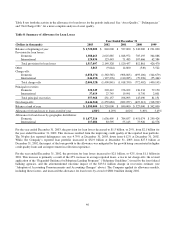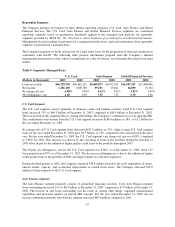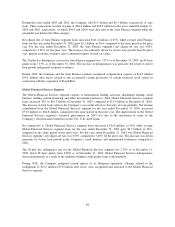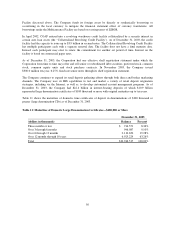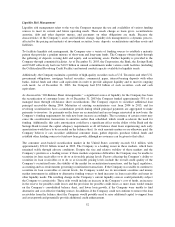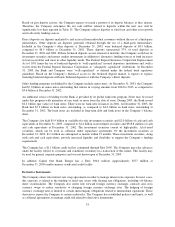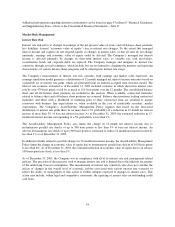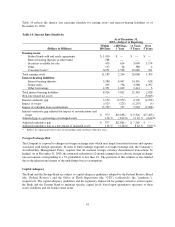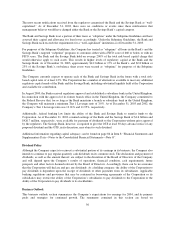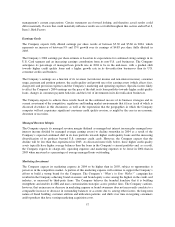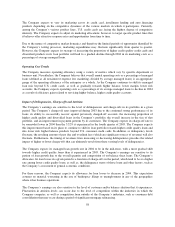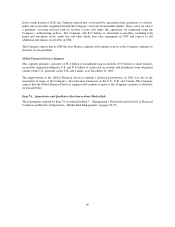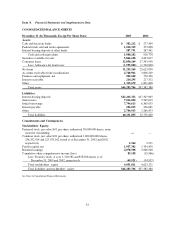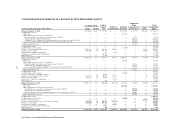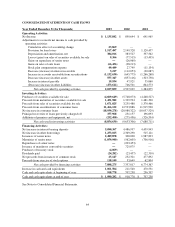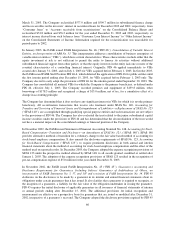Capital One 2003 Annual Report Download - page 74
Download and view the complete annual report
Please find page 74 of the 2003 Capital One annual report below. You can navigate through the pages in the report by either clicking on the pages listed below, or by using the keyword search tool below to find specific information within the annual report.The most recent notifications received from the regulators categorized the Bank and the Savings Bank as “well-
capitalized.” As of December 31, 2003, there were no conditions or events since these notifications that
management believes would have changed either the Bank or the Savings Bank’s capital category.
The Bank and Savings Bank treat a portion of their loans as “subprime” under the Subprime Guidelines and have
assessed their capital and allowance for loan losses accordingly. Under the Subprime Guidelines, the Bank and
Savings Bank each exceeds the requirements for a “well-capitalized” institution as of December 31, 2003.
For purposes of the Subprime Guidelines, the Company has treated as “subprime” all loans in the Bank’s and the
Savings Bank’s targeted “subprime” programs to customers either with a FICO score of 660 or below or with no
FICO score. The Bank and the Savings Bank hold on average 200% of the total risk-based capital charge that
would otherwise apply to such assets. This results in higher levels of regulatory capital at the Bank and the
Savings Bank. As of December 31, 2003, approximately $4.2 billion or 17% of the Bank’s, and $2.8 billion or
23% of the Savings Bank’s, on-balance sheet assets were treated as “subprime” for purposes of the Subprime
Guidelines.
The Company currently expects to operate each of the Bank and Savings Bank in the future with a total risk-
based capital ratio of at least 12%. The Corporation has a number of alternatives available to meet any additional
regulatory capital needs of the Bank and the Savings Bank, including substantial liquidity held at the Corporation
and available for contribution.
In August 2000, the Bank received regulatory approval and established a subsidiary bank in the United Kingdom.
In connection with the approval of its former branch office in the United Kingdom, the Company committed to
the Federal Reserve that, for so long as the Bank maintains a branch or subsidiary bank in the United Kingdom,
the Company will maintain a minimum Tier 1 Leverage ratio of 3.0%. As of December 31, 2003 and 2002, the
Company’s Tier 1 Leverage ratio was 13.01% and 11.95%, respectively.
Additionally, federal banking law limits the ability of the Bank and Savings Bank to transfer funds to the
Corporation. As of December 31, 2003, retained earnings of the Bank and the Savings Bank of $1.6 billion and
$426.7 million, respectively, were available for payment of dividends to the Corporation without prior approval
by the regulators. The Savings Bank, however, is required to give the OTS at least 30 days advance notice of any
proposed dividend and the OTS, in its discretion, may object to such dividend.
Additional information regarding capital adequacy can be found on page 86 in Item 8 “Financial Statements and
Supplementary Data—Notes to the Consolidated Financial Statements—Note O”.
Dividend Policy
Although the Company expects to reinvest a substantial portion of its earnings in its business, the Company also
intends to continue to pay regular quarterly cash dividends on its common stock. The declaration and payment of
dividends, as well as the amount thereof, are subject to the discretion of the Board of Directors of the Company
and will depend upon the Company’s results of operations, financial condition, cash requirements, future
prospects and other factors deemed relevant by the Board of Directors. Accordingly, there can be no assurance
that the Corporation will declare and pay any dividends. As a holding company, the ability of the Corporation to
pay dividends is dependent upon the receipt of dividends or other payments from its subsidiaries. Applicable
banking regulations and provisions that may be contained in borrowing agreements of the Corporation or its
subsidiaries may restrict the ability of the Corporation’s subsidiaries to pay dividends to the Corporation or the
ability of the Corporation to pay dividends to its stockholders.
Business Outlook
This business outlook section summarizes the Company’s expectations for earnings for 2004, and its primary
goals and strategies for continued growth. The statements contained in this section are based on
56


